BA (Hons) Business Processes: Quality Management and Project Success
VerifiedAdded on 2023/01/05
|13
|5044
|68
Report
AI Summary
This report, prepared for Arden University's BA (Hons) Business Processes course, delves into the critical aspects of quality management and project success. It begins by highlighting the significance of quality as a key operational tactic in the global market, focusing on the four main components of quality management: planning, assurance, control, and improvement. The report uses a case study of Delight Hotel to illustrate approaches to quality management, including external benchmarking, employee engagement, and customer focus. It contrasts Delight Hotel with Midas Hotel, analyzing their approaches to strategic leadership, benchmarking, employee involvement, customer satisfaction, and technology adoption. Furthermore, the report explores project success, defining it in terms of meeting investor expectations and delivering value, and discusses two measurement dimensions: the triple constraint (scope, schedule, cost) and project strategic value. It outlines essential elements for project success, such as cohesive planning, a distinct leader, a dedicated team, and effective communication. The report also examines business process analysis, emphasizing the importance of self-assessment, process mapping, and performance measurement to identify and improve organizational processes. Overall, the report offers a comprehensive overview of quality management, project success, and business process analysis, providing valuable insights for business development.
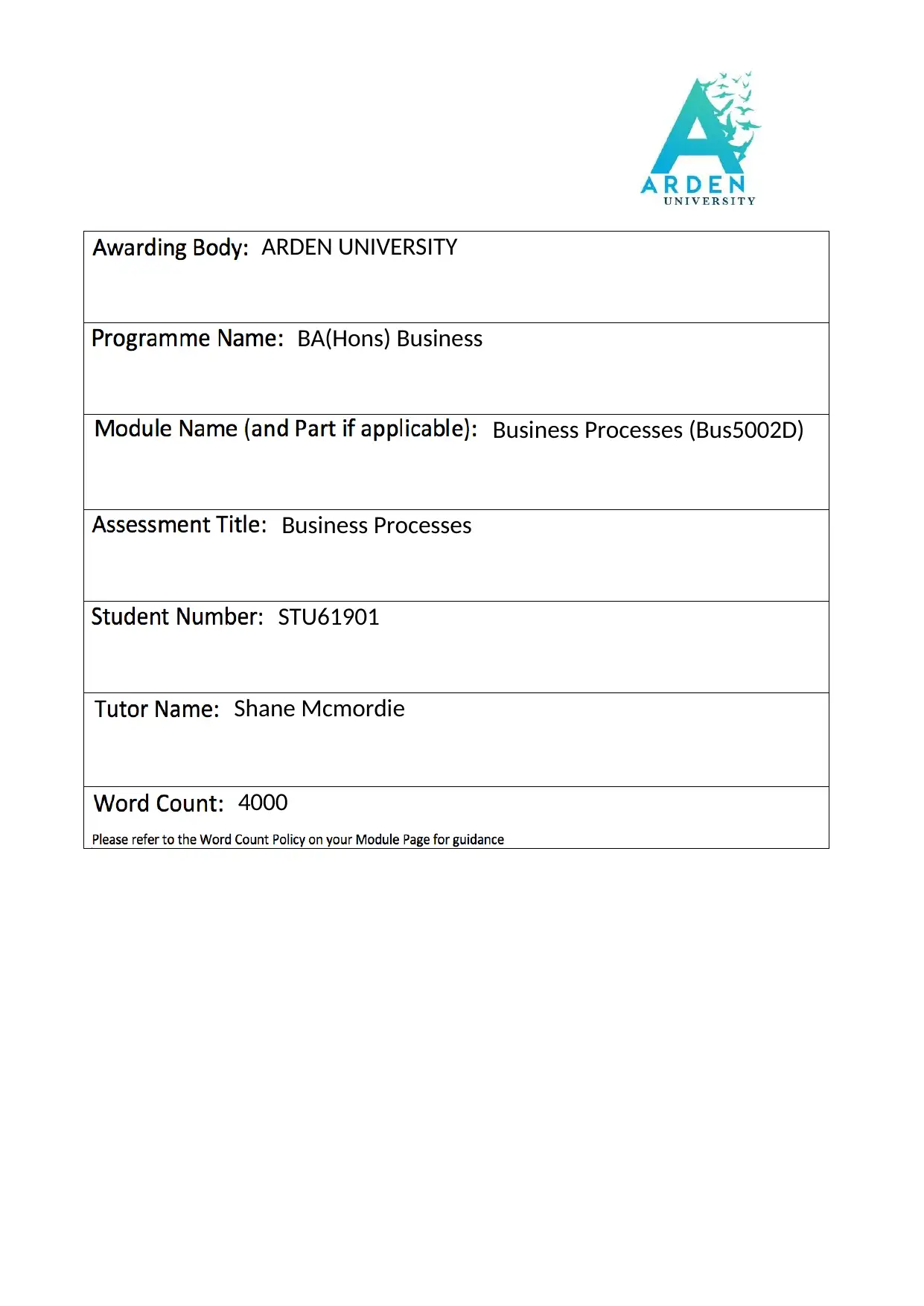
ARDEN UNIVERSITY
BA(Hons) Business
Business Processes (Bus5002D)
Business Processes
STU61901
Shane Mcmordie
4000
BA(Hons) Business
Business Processes (Bus5002D)
Business Processes
STU61901
Shane Mcmordie
4000
Paraphrase This Document
Need a fresh take? Get an instant paraphrase of this document with our AI Paraphraser
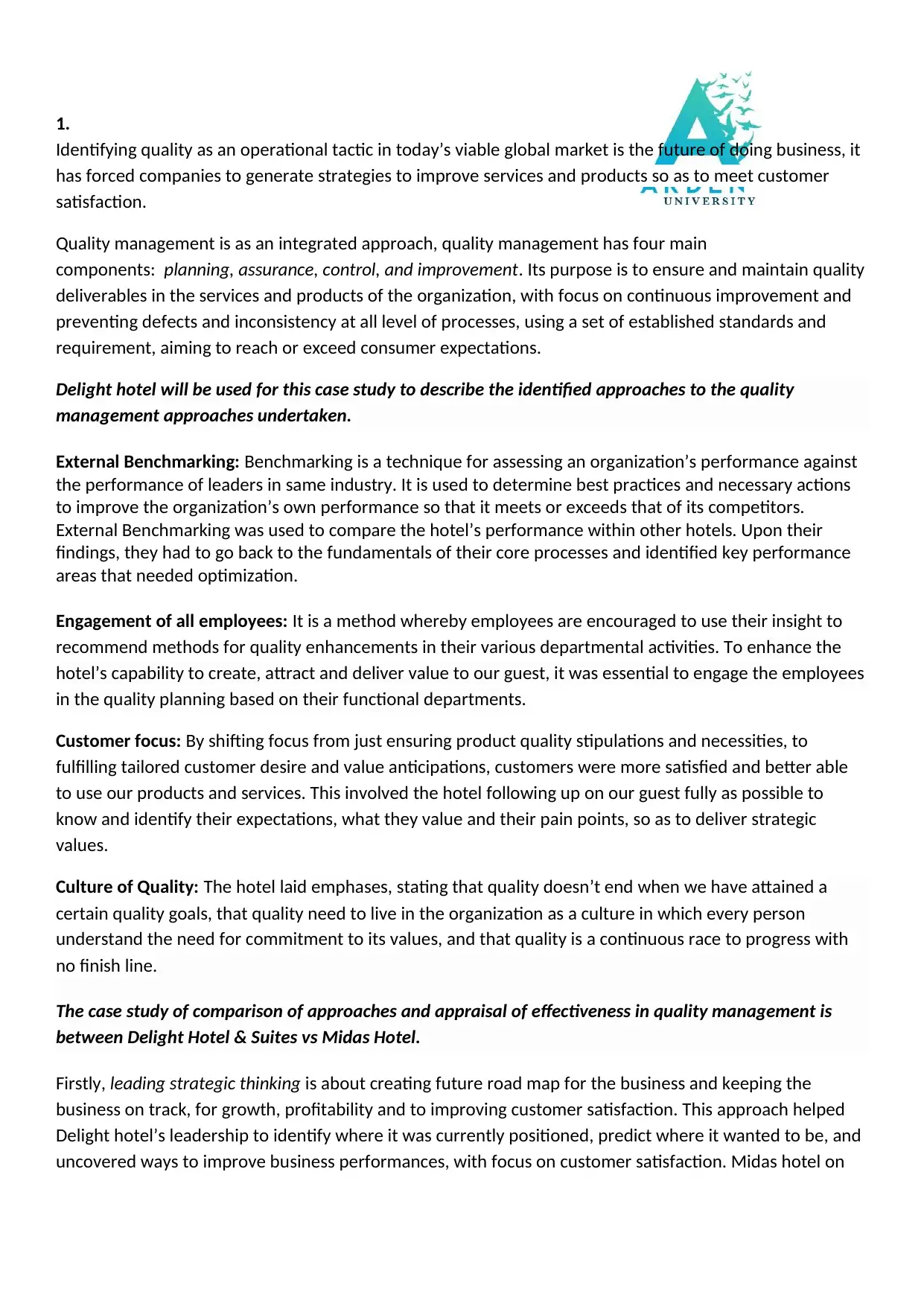
1.
Identifying quality as an operational tactic in today’s viable global market is the future of doing business, it
has forced companies to generate strategies to improve services and products so as to meet customer
satisfaction.
Quality management is as an integrated approach, quality management has four main
components: planning, assurance, control, and improvement. Its purpose is to ensure and maintain quality
deliverables in the services and products of the organization, with focus on continuous improvement and
preventing defects and inconsistency at all level of processes, using a set of established standards and
requirement, aiming to reach or exceed consumer expectations.
Delight hotel will be used for this case study to describe the identified approaches to the quality
management approaches undertaken.
External Benchmarking: Benchmarking is a technique for assessing an organization’s performance against
the performance of leaders in same industry. It is used to determine best practices and necessary actions
to improve the organization’s own performance so that it meets or exceeds that of its competitors.
External Benchmarking was used to compare the hotel’s performance within other hotels. Upon their
findings, they had to go back to the fundamentals of their core processes and identified key performance
areas that needed optimization.
Engagement of all employees: It is a method whereby employees are encouraged to use their insight to
recommend methods for quality enhancements in their various departmental activities. To enhance the
hotel’s capability to create, attract and deliver value to our guest, it was essential to engage the employees
in the quality planning based on their functional departments.
Customer focus: By shifting focus from just ensuring product quality stipulations and necessities, to
fulfilling tailored customer desire and value anticipations, customers were more satisfied and better able
to use our products and services. This involved the hotel following up on our guest fully as possible to
know and identify their expectations, what they value and their pain points, so as to deliver strategic
values.
Culture of Quality: The hotel laid emphases, stating that quality doesn’t end when we have attained a
certain quality goals, that quality need to live in the organization as a culture in which every person
understand the need for commitment to its values, and that quality is a continuous race to progress with
no finish line.
The case study of comparison of approaches and appraisal of effectiveness in quality management is
between Delight Hotel & Suites vs Midas Hotel.
Firstly, leading strategic thinking is about creating future road map for the business and keeping the
business on track, for growth, profitability and to improving customer satisfaction. This approach helped
Delight hotel’s leadership to identify where it was currently positioned, predict where it wanted to be, and
uncovered ways to improve business performances, with focus on customer satisfaction. Midas hotel on
Identifying quality as an operational tactic in today’s viable global market is the future of doing business, it
has forced companies to generate strategies to improve services and products so as to meet customer
satisfaction.
Quality management is as an integrated approach, quality management has four main
components: planning, assurance, control, and improvement. Its purpose is to ensure and maintain quality
deliverables in the services and products of the organization, with focus on continuous improvement and
preventing defects and inconsistency at all level of processes, using a set of established standards and
requirement, aiming to reach or exceed consumer expectations.
Delight hotel will be used for this case study to describe the identified approaches to the quality
management approaches undertaken.
External Benchmarking: Benchmarking is a technique for assessing an organization’s performance against
the performance of leaders in same industry. It is used to determine best practices and necessary actions
to improve the organization’s own performance so that it meets or exceeds that of its competitors.
External Benchmarking was used to compare the hotel’s performance within other hotels. Upon their
findings, they had to go back to the fundamentals of their core processes and identified key performance
areas that needed optimization.
Engagement of all employees: It is a method whereby employees are encouraged to use their insight to
recommend methods for quality enhancements in their various departmental activities. To enhance the
hotel’s capability to create, attract and deliver value to our guest, it was essential to engage the employees
in the quality planning based on their functional departments.
Customer focus: By shifting focus from just ensuring product quality stipulations and necessities, to
fulfilling tailored customer desire and value anticipations, customers were more satisfied and better able
to use our products and services. This involved the hotel following up on our guest fully as possible to
know and identify their expectations, what they value and their pain points, so as to deliver strategic
values.
Culture of Quality: The hotel laid emphases, stating that quality doesn’t end when we have attained a
certain quality goals, that quality need to live in the organization as a culture in which every person
understand the need for commitment to its values, and that quality is a continuous race to progress with
no finish line.
The case study of comparison of approaches and appraisal of effectiveness in quality management is
between Delight Hotel & Suites vs Midas Hotel.
Firstly, leading strategic thinking is about creating future road map for the business and keeping the
business on track, for growth, profitability and to improving customer satisfaction. This approach helped
Delight hotel’s leadership to identify where it was currently positioned, predict where it wanted to be, and
uncovered ways to improve business performances, with focus on customer satisfaction. Midas hotel on
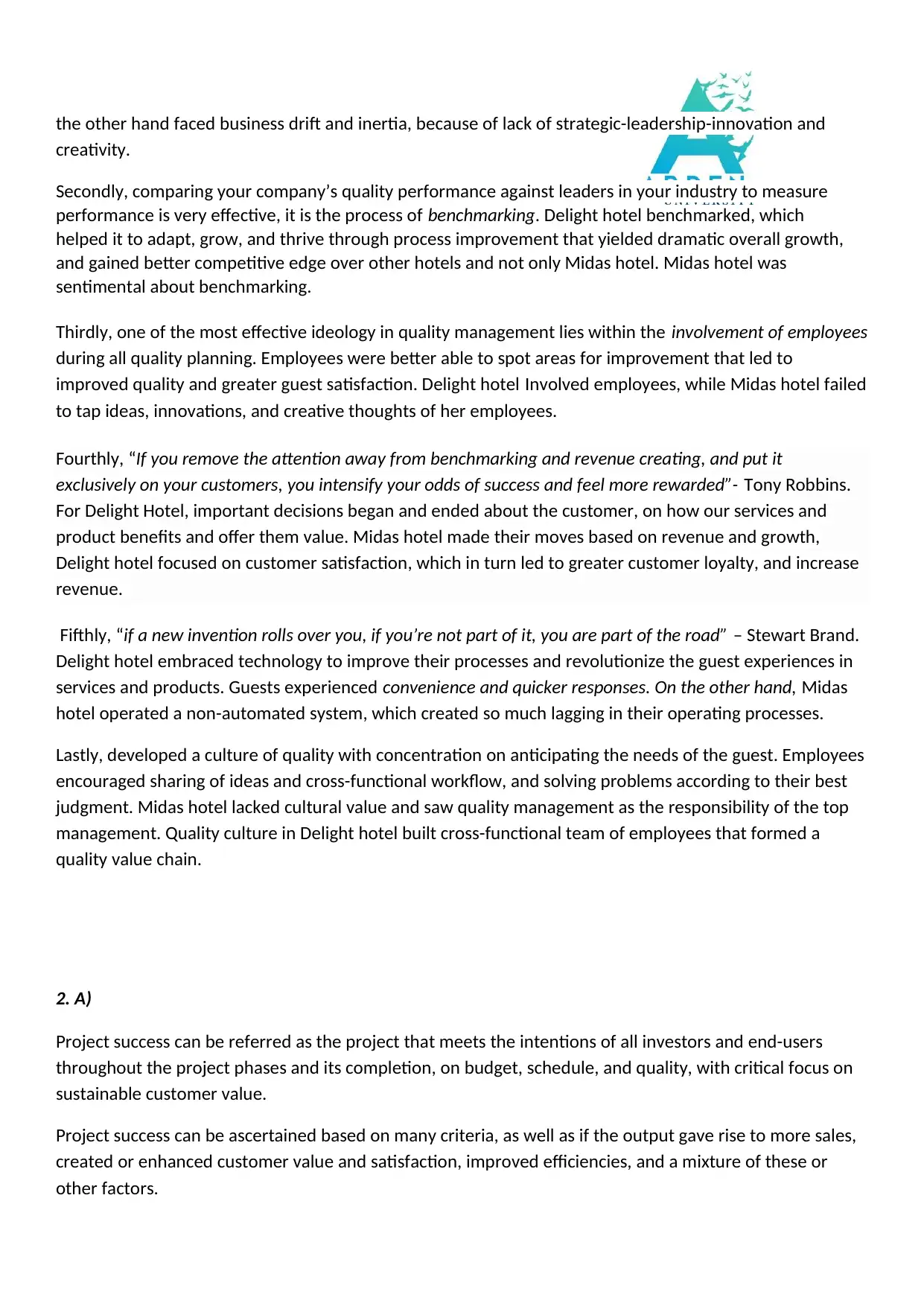
the other hand faced business drift and inertia, because of lack of strategic-leadership-innovation and
creativity.
Secondly, comparing your company’s quality performance against leaders in your industry to measure
performance is very effective, it is the process of benchmarking. Delight hotel benchmarked, which
helped it to adapt, grow, and thrive through process improvement that yielded dramatic overall growth,
and gained better competitive edge over other hotels and not only Midas hotel. Midas hotel was
sentimental about benchmarking.
Thirdly, one of the most effective ideology in quality management lies within the involvement of employees
during all quality planning. Employees were better able to spot areas for improvement that led to
improved quality and greater guest satisfaction. Delight hotel Involved employees, while Midas hotel failed
to tap ideas, innovations, and creative thoughts of her employees.
Fourthly, “If you remove the attention away from benchmarking and revenue creating, and put it
exclusively on your customers, you intensify your odds of success and feel more rewarded”- Tony Robbins.
For Delight Hotel, important decisions began and ended about the customer, on how our services and
product benefits and offer them value. Midas hotel made their moves based on revenue and growth,
Delight hotel focused on customer satisfaction, which in turn led to greater customer loyalty, and increase
revenue.
Fifthly, “if a new invention rolls over you, if you’re not part of it, you are part of the road” – Stewart Brand.
Delight hotel embraced technology to improve their processes and revolutionize the guest experiences in
services and products. Guests experienced convenience and quicker responses. On the other hand, Midas
hotel operated a non-automated system, which created so much lagging in their operating processes.
Lastly, developed a culture of quality with concentration on anticipating the needs of the guest. Employees
encouraged sharing of ideas and cross-functional workflow, and solving problems according to their best
judgment. Midas hotel lacked cultural value and saw quality management as the responsibility of the top
management. Quality culture in Delight hotel built cross-functional team of employees that formed a
quality value chain.
2. A)
Project success can be referred as the project that meets the intentions of all investors and end-users
throughout the project phases and its completion, on budget, schedule, and quality, with critical focus on
sustainable customer value.
Project success can be ascertained based on many criteria, as well as if the output gave rise to more sales,
created or enhanced customer value and satisfaction, improved efficiencies, and a mixture of these or
other factors.
creativity.
Secondly, comparing your company’s quality performance against leaders in your industry to measure
performance is very effective, it is the process of benchmarking. Delight hotel benchmarked, which
helped it to adapt, grow, and thrive through process improvement that yielded dramatic overall growth,
and gained better competitive edge over other hotels and not only Midas hotel. Midas hotel was
sentimental about benchmarking.
Thirdly, one of the most effective ideology in quality management lies within the involvement of employees
during all quality planning. Employees were better able to spot areas for improvement that led to
improved quality and greater guest satisfaction. Delight hotel Involved employees, while Midas hotel failed
to tap ideas, innovations, and creative thoughts of her employees.
Fourthly, “If you remove the attention away from benchmarking and revenue creating, and put it
exclusively on your customers, you intensify your odds of success and feel more rewarded”- Tony Robbins.
For Delight Hotel, important decisions began and ended about the customer, on how our services and
product benefits and offer them value. Midas hotel made their moves based on revenue and growth,
Delight hotel focused on customer satisfaction, which in turn led to greater customer loyalty, and increase
revenue.
Fifthly, “if a new invention rolls over you, if you’re not part of it, you are part of the road” – Stewart Brand.
Delight hotel embraced technology to improve their processes and revolutionize the guest experiences in
services and products. Guests experienced convenience and quicker responses. On the other hand, Midas
hotel operated a non-automated system, which created so much lagging in their operating processes.
Lastly, developed a culture of quality with concentration on anticipating the needs of the guest. Employees
encouraged sharing of ideas and cross-functional workflow, and solving problems according to their best
judgment. Midas hotel lacked cultural value and saw quality management as the responsibility of the top
management. Quality culture in Delight hotel built cross-functional team of employees that formed a
quality value chain.
2. A)
Project success can be referred as the project that meets the intentions of all investors and end-users
throughout the project phases and its completion, on budget, schedule, and quality, with critical focus on
sustainable customer value.
Project success can be ascertained based on many criteria, as well as if the output gave rise to more sales,
created or enhanced customer value and satisfaction, improved efficiencies, and a mixture of these or
other factors.
⊘ This is a preview!⊘
Do you want full access?
Subscribe today to unlock all pages.

Trusted by 1+ million students worldwide
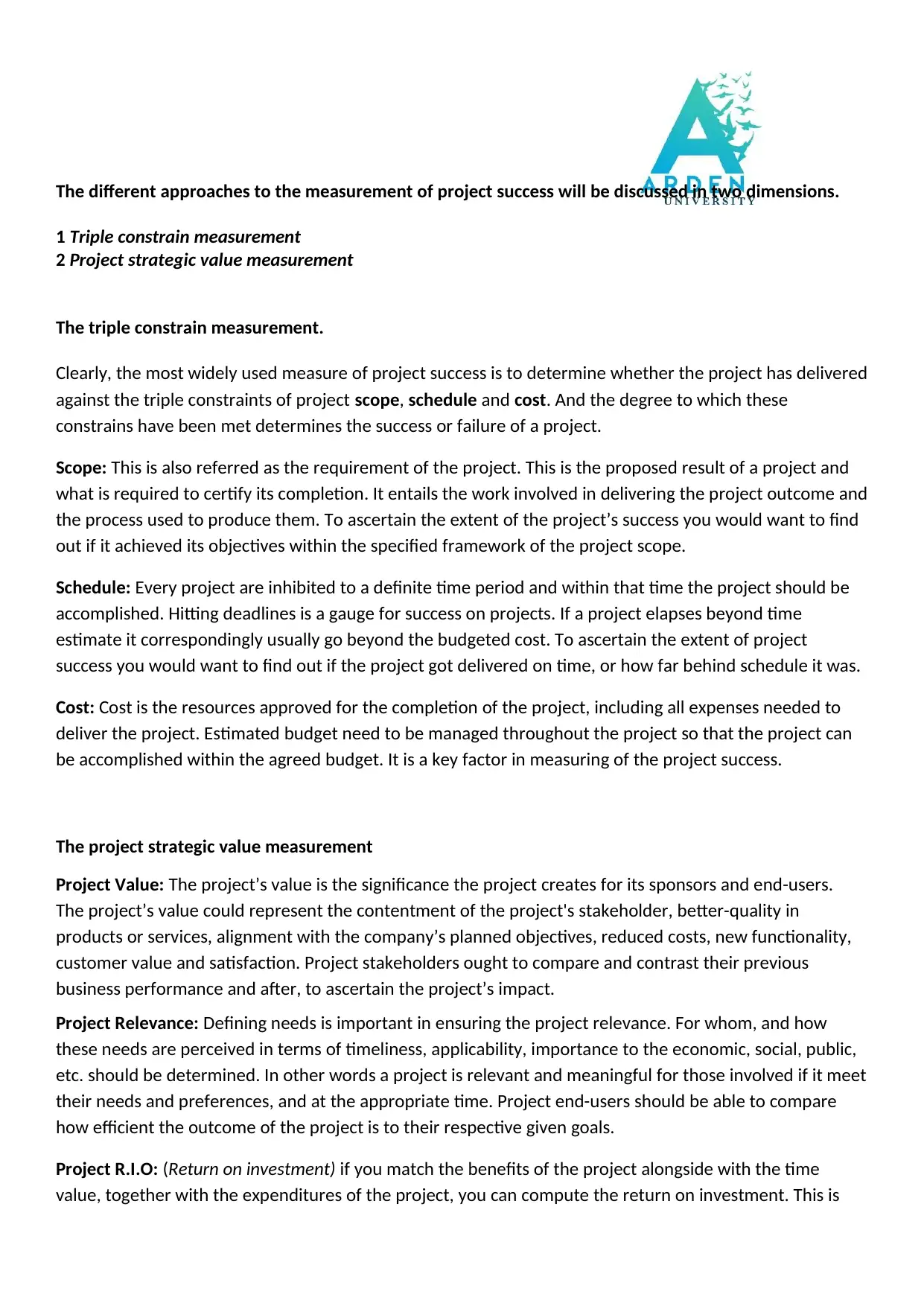
The different approaches to the measurement of project success will be discussed in two dimensions.
1 Triple constrain measurement
2 Project strategic value measurement
The triple constrain measurement.
Clearly, the most widely used measure of project success is to determine whether the project has delivered
against the triple constraints of project scope, schedule and cost. And the degree to which these
constrains have been met determines the success or failure of a project.
Scope: This is also referred as the requirement of the project. This is the proposed result of a project and
what is required to certify its completion. It entails the work involved in delivering the project outcome and
the process used to produce them. To ascertain the extent of the project’s success you would want to find
out if it achieved its objectives within the specified framework of the project scope.
Schedule: Every project are inhibited to a definite time period and within that time the project should be
accomplished. Hitting deadlines is a gauge for success on projects. If a project elapses beyond time
estimate it correspondingly usually go beyond the budgeted cost. To ascertain the extent of project
success you would want to find out if the project got delivered on time, or how far behind schedule it was.
Cost: Cost is the resources approved for the completion of the project, including all expenses needed to
deliver the project. Estimated budget need to be managed throughout the project so that the project can
be accomplished within the agreed budget. It is a key factor in measuring of the project success.
The project strategic value measurement
Project Value: The project’s value is the significance the project creates for its sponsors and end-users.
The project’s value could represent the contentment of the project's stakeholder, better-quality in
products or services, alignment with the company’s planned objectives, reduced costs, new functionality,
customer value and satisfaction. Project stakeholders ought to compare and contrast their previous
business performance and after, to ascertain the project’s impact.
Project Relevance: Defining needs is important in ensuring the project relevance. For whom, and how
these needs are perceived in terms of timeliness, applicability, importance to the economic, social, public,
etc. should be determined. In other words a project is relevant and meaningful for those involved if it meet
their needs and preferences, and at the appropriate time. Project end-users should be able to compare
how efficient the outcome of the project is to their respective given goals.
Project R.I.O: (Return on investment) if you match the benefits of the project alongside with the time
value, together with the expenditures of the project, you can compute the return on investment. This is
1 Triple constrain measurement
2 Project strategic value measurement
The triple constrain measurement.
Clearly, the most widely used measure of project success is to determine whether the project has delivered
against the triple constraints of project scope, schedule and cost. And the degree to which these
constrains have been met determines the success or failure of a project.
Scope: This is also referred as the requirement of the project. This is the proposed result of a project and
what is required to certify its completion. It entails the work involved in delivering the project outcome and
the process used to produce them. To ascertain the extent of the project’s success you would want to find
out if it achieved its objectives within the specified framework of the project scope.
Schedule: Every project are inhibited to a definite time period and within that time the project should be
accomplished. Hitting deadlines is a gauge for success on projects. If a project elapses beyond time
estimate it correspondingly usually go beyond the budgeted cost. To ascertain the extent of project
success you would want to find out if the project got delivered on time, or how far behind schedule it was.
Cost: Cost is the resources approved for the completion of the project, including all expenses needed to
deliver the project. Estimated budget need to be managed throughout the project so that the project can
be accomplished within the agreed budget. It is a key factor in measuring of the project success.
The project strategic value measurement
Project Value: The project’s value is the significance the project creates for its sponsors and end-users.
The project’s value could represent the contentment of the project's stakeholder, better-quality in
products or services, alignment with the company’s planned objectives, reduced costs, new functionality,
customer value and satisfaction. Project stakeholders ought to compare and contrast their previous
business performance and after, to ascertain the project’s impact.
Project Relevance: Defining needs is important in ensuring the project relevance. For whom, and how
these needs are perceived in terms of timeliness, applicability, importance to the economic, social, public,
etc. should be determined. In other words a project is relevant and meaningful for those involved if it meet
their needs and preferences, and at the appropriate time. Project end-users should be able to compare
how efficient the outcome of the project is to their respective given goals.
Project R.I.O: (Return on investment) if you match the benefits of the project alongside with the time
value, together with the expenditures of the project, you can compute the return on investment. This is
Paraphrase This Document
Need a fresh take? Get an instant paraphrase of this document with our AI Paraphraser
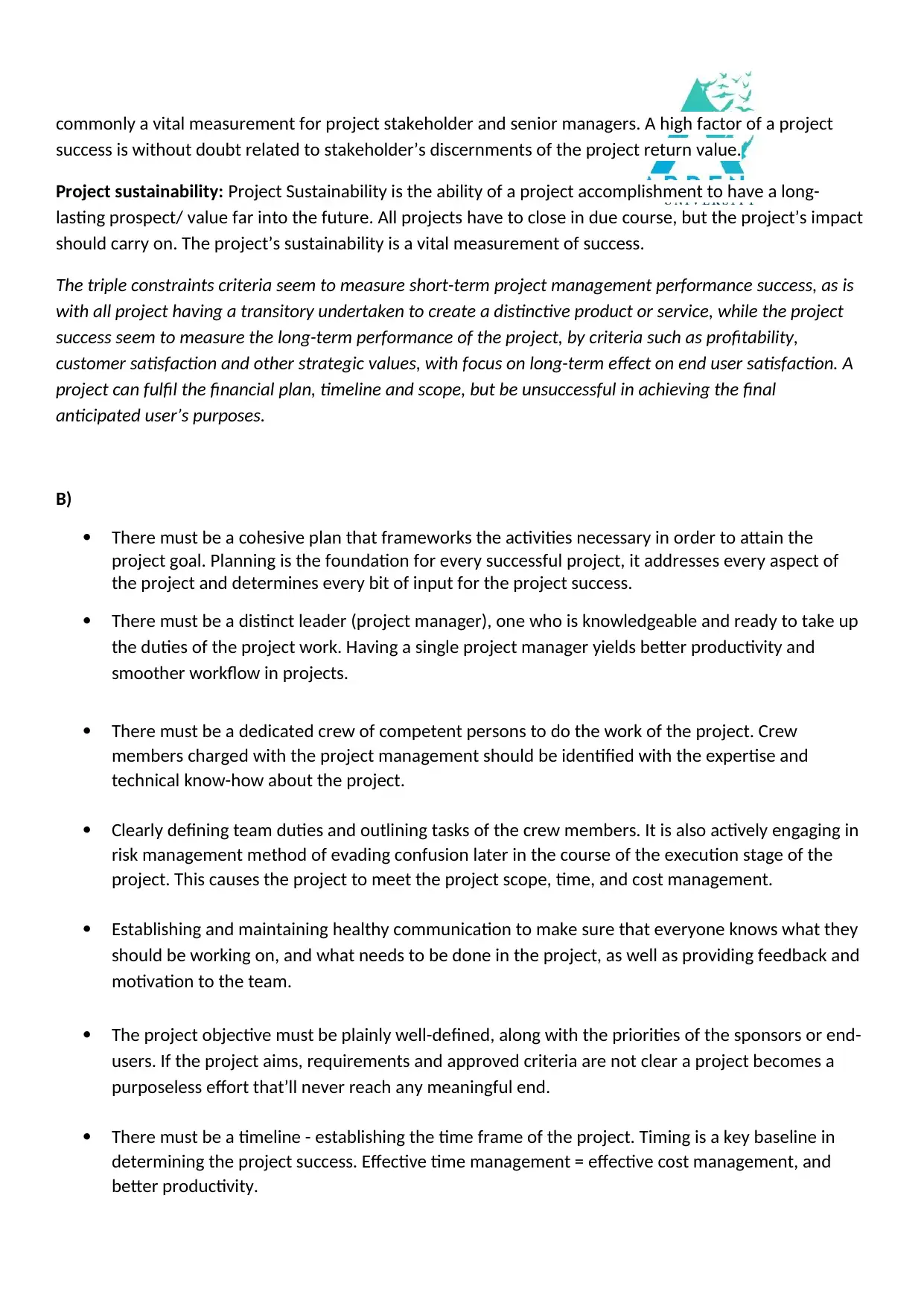
commonly a vital measurement for project stakeholder and senior managers. A high factor of a project
success is without doubt related to stakeholder’s discernments of the project return value.
Project sustainability: Project Sustainability is the ability of a project accomplishment to have a long-
lasting prospect/ value far into the future. All projects have to close in due course, but the project’s impact
should carry on. The project’s sustainability is a vital measurement of success.
The triple constraints criteria seem to measure short-term project management performance success, as is
with all project having a transitory undertaken to create a distinctive product or service, while the project
success seem to measure the long-term performance of the project, by criteria such as profitability,
customer satisfaction and other strategic values, with focus on long-term effect on end user satisfaction. A
project can fulfil the financial plan, timeline and scope, but be unsuccessful in achieving the final
anticipated user’s purposes.
B)
There must be a cohesive plan that frameworks the activities necessary in order to attain the
project goal. Planning is the foundation for every successful project, it addresses every aspect of
the project and determines every bit of input for the project success.
There must be a distinct leader (project manager), one who is knowledgeable and ready to take up
the duties of the project work. Having a single project manager yields better productivity and
smoother workflow in projects.
There must be a dedicated crew of competent persons to do the work of the project. Crew
members charged with the project management should be identified with the expertise and
technical know-how about the project.
Clearly defining team duties and outlining tasks of the crew members. It is also actively engaging in
risk management method of evading confusion later in the course of the execution stage of the
project. This causes the project to meet the project scope, time, and cost management.
Establishing and maintaining healthy communication to make sure that everyone knows what they
should be working on, and what needs to be done in the project, as well as providing feedback and
motivation to the team.
The project objective must be plainly well-defined, along with the priorities of the sponsors or end-
users. If the project aims, requirements and approved criteria are not clear a project becomes a
purposeless effort that’ll never reach any meaningful end.
There must be a timeline - establishing the time frame of the project. Timing is a key baseline in
determining the project success. Effective time management = effective cost management, and
better productivity.
success is without doubt related to stakeholder’s discernments of the project return value.
Project sustainability: Project Sustainability is the ability of a project accomplishment to have a long-
lasting prospect/ value far into the future. All projects have to close in due course, but the project’s impact
should carry on. The project’s sustainability is a vital measurement of success.
The triple constraints criteria seem to measure short-term project management performance success, as is
with all project having a transitory undertaken to create a distinctive product or service, while the project
success seem to measure the long-term performance of the project, by criteria such as profitability,
customer satisfaction and other strategic values, with focus on long-term effect on end user satisfaction. A
project can fulfil the financial plan, timeline and scope, but be unsuccessful in achieving the final
anticipated user’s purposes.
B)
There must be a cohesive plan that frameworks the activities necessary in order to attain the
project goal. Planning is the foundation for every successful project, it addresses every aspect of
the project and determines every bit of input for the project success.
There must be a distinct leader (project manager), one who is knowledgeable and ready to take up
the duties of the project work. Having a single project manager yields better productivity and
smoother workflow in projects.
There must be a dedicated crew of competent persons to do the work of the project. Crew
members charged with the project management should be identified with the expertise and
technical know-how about the project.
Clearly defining team duties and outlining tasks of the crew members. It is also actively engaging in
risk management method of evading confusion later in the course of the execution stage of the
project. This causes the project to meet the project scope, time, and cost management.
Establishing and maintaining healthy communication to make sure that everyone knows what they
should be working on, and what needs to be done in the project, as well as providing feedback and
motivation to the team.
The project objective must be plainly well-defined, along with the priorities of the sponsors or end-
users. If the project aims, requirements and approved criteria are not clear a project becomes a
purposeless effort that’ll never reach any meaningful end.
There must be a timeline - establishing the time frame of the project. Timing is a key baseline in
determining the project success. Effective time management = effective cost management, and
better productivity.
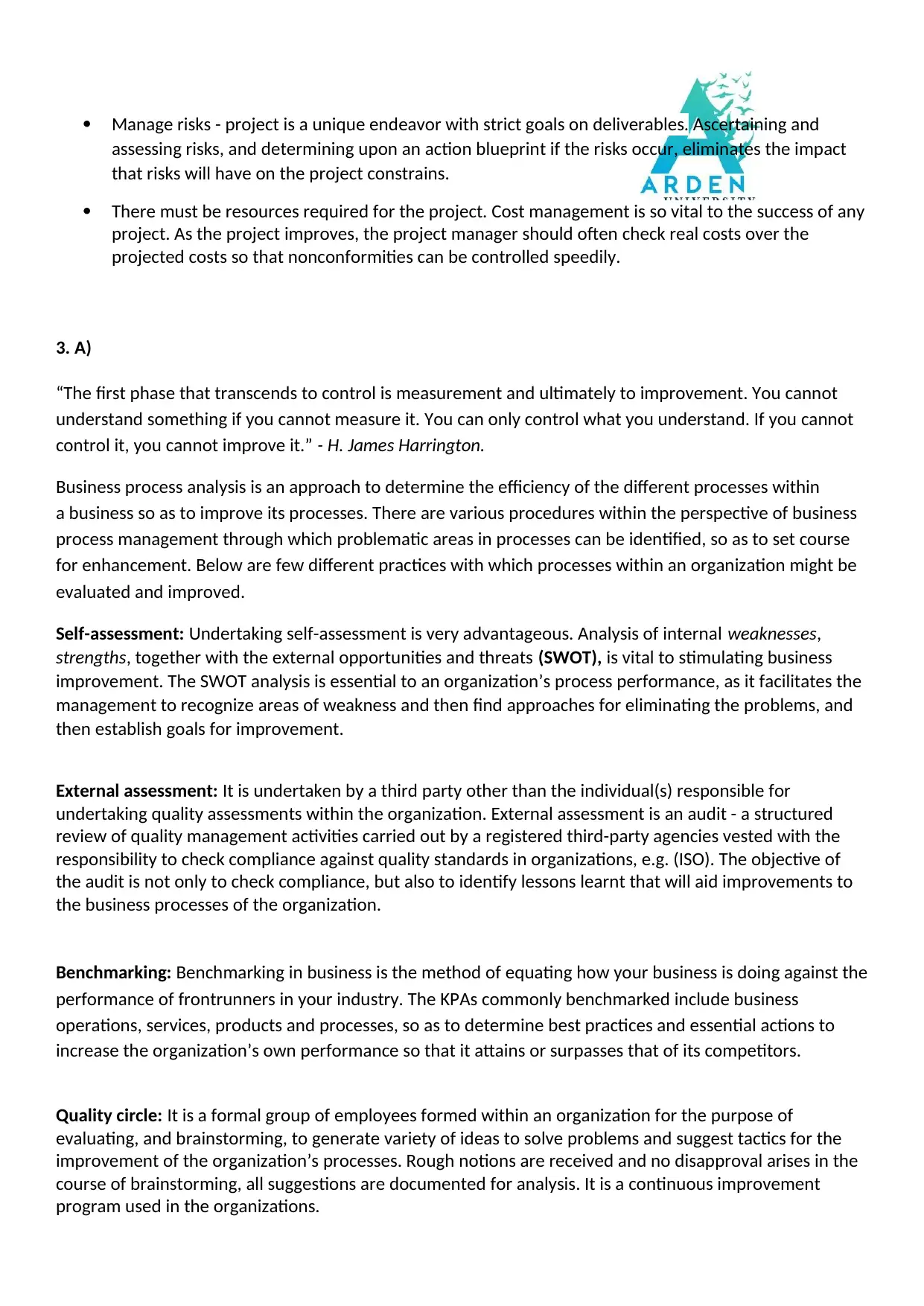
Manage risks - project is a unique endeavor with strict goals on deliverables. Ascertaining and
assessing risks, and determining upon an action blueprint if the risks occur, eliminates the impact
that risks will have on the project constrains.
There must be resources required for the project. Cost management is so vital to the success of any
project. As the project improves, the project manager should often check real costs over the
projected costs so that nonconformities can be controlled speedily.
3. A)
“The first phase that transcends to control is measurement and ultimately to improvement. You cannot
understand something if you cannot measure it. You can only control what you understand. If you cannot
control it, you cannot improve it.” - H. James Harrington.
Business process analysis is an approach to determine the efficiency of the different processes within
a business so as to improve its processes. There are various procedures within the perspective of business
process management through which problematic areas in processes can be identified, so as to set course
for enhancement. Below are few different practices with which processes within an organization might be
evaluated and improved.
Self-assessment: Undertaking self-assessment is very advantageous. Analysis of internal weaknesses,
strengths, together with the external opportunities and threats (SWOT), is vital to stimulating business
improvement. The SWOT analysis is essential to an organization’s process performance, as it facilitates the
management to recognize areas of weakness and then find approaches for eliminating the problems, and
then establish goals for improvement.
External assessment: It is undertaken by a third party other than the individual(s) responsible for
undertaking quality assessments within the organization. External assessment is an audit - a structured
review of quality management activities carried out by a registered third-party agencies vested with the
responsibility to check compliance against quality standards in organizations, e.g. (ISO). The objective of
the audit is not only to check compliance, but also to identify lessons learnt that will aid improvements to
the business processes of the organization.
Benchmarking: Benchmarking in business is the method of equating how your business is doing against the
performance of frontrunners in your industry. The KPAs commonly benchmarked include business
operations, services, products and processes, so as to determine best practices and essential actions to
increase the organization’s own performance so that it attains or surpasses that of its competitors.
Quality circle: It is a formal group of employees formed within an organization for the purpose of
evaluating, and brainstorming, to generate variety of ideas to solve problems and suggest tactics for the
improvement of the organization’s processes. Rough notions are received and no disapproval arises in the
course of brainstorming, all suggestions are documented for analysis. It is a continuous improvement
program used in the organizations.
assessing risks, and determining upon an action blueprint if the risks occur, eliminates the impact
that risks will have on the project constrains.
There must be resources required for the project. Cost management is so vital to the success of any
project. As the project improves, the project manager should often check real costs over the
projected costs so that nonconformities can be controlled speedily.
3. A)
“The first phase that transcends to control is measurement and ultimately to improvement. You cannot
understand something if you cannot measure it. You can only control what you understand. If you cannot
control it, you cannot improve it.” - H. James Harrington.
Business process analysis is an approach to determine the efficiency of the different processes within
a business so as to improve its processes. There are various procedures within the perspective of business
process management through which problematic areas in processes can be identified, so as to set course
for enhancement. Below are few different practices with which processes within an organization might be
evaluated and improved.
Self-assessment: Undertaking self-assessment is very advantageous. Analysis of internal weaknesses,
strengths, together with the external opportunities and threats (SWOT), is vital to stimulating business
improvement. The SWOT analysis is essential to an organization’s process performance, as it facilitates the
management to recognize areas of weakness and then find approaches for eliminating the problems, and
then establish goals for improvement.
External assessment: It is undertaken by a third party other than the individual(s) responsible for
undertaking quality assessments within the organization. External assessment is an audit - a structured
review of quality management activities carried out by a registered third-party agencies vested with the
responsibility to check compliance against quality standards in organizations, e.g. (ISO). The objective of
the audit is not only to check compliance, but also to identify lessons learnt that will aid improvements to
the business processes of the organization.
Benchmarking: Benchmarking in business is the method of equating how your business is doing against the
performance of frontrunners in your industry. The KPAs commonly benchmarked include business
operations, services, products and processes, so as to determine best practices and essential actions to
increase the organization’s own performance so that it attains or surpasses that of its competitors.
Quality circle: It is a formal group of employees formed within an organization for the purpose of
evaluating, and brainstorming, to generate variety of ideas to solve problems and suggest tactics for the
improvement of the organization’s processes. Rough notions are received and no disapproval arises in the
course of brainstorming, all suggestions are documented for analysis. It is a continuous improvement
program used in the organizations.
⊘ This is a preview!⊘
Do you want full access?
Subscribe today to unlock all pages.

Trusted by 1+ million students worldwide
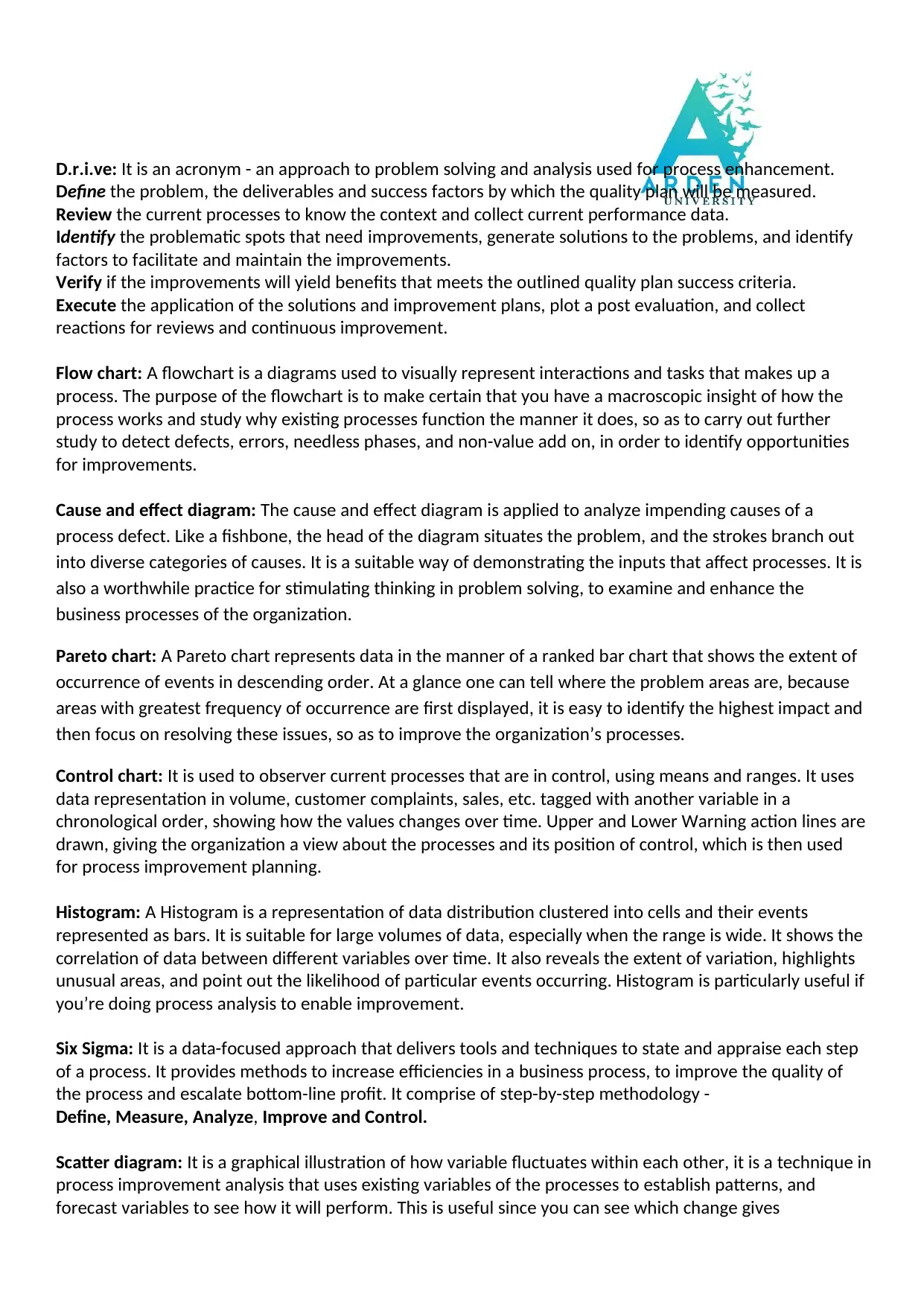
D.r.i.ve: It is an acronym - an approach to problem solving and analysis used for process enhancement.
Define the problem, the deliverables and success factors by which the quality plan will be measured.
Review the current processes to know the context and collect current performance data.
Identify the problematic spots that need improvements, generate solutions to the problems, and identify
factors to facilitate and maintain the improvements.
Verify if the improvements will yield benefits that meets the outlined quality plan success criteria.
Execute the application of the solutions and improvement plans, plot a post evaluation, and collect
reactions for reviews and continuous improvement.
Flow chart: A flowchart is a diagrams used to visually represent interactions and tasks that makes up a
process. The purpose of the flowchart is to make certain that you have a macroscopic insight of how the
process works and study why existing processes function the manner it does, so as to carry out further
study to detect defects, errors, needless phases, and non-value add on, in order to identify opportunities
for improvements.
Cause and effect diagram: The cause and effect diagram is applied to analyze impending causes of a
process defect. Like a fishbone, the head of the diagram situates the problem, and the strokes branch out
into diverse categories of causes. It is a suitable way of demonstrating the inputs that affect processes. It is
also a worthwhile practice for stimulating thinking in problem solving, to examine and enhance the
business processes of the organization.
Pareto chart: A Pareto chart represents data in the manner of a ranked bar chart that shows the extent of
occurrence of events in descending order. At a glance one can tell where the problem areas are, because
areas with greatest frequency of occurrence are first displayed, it is easy to identify the highest impact and
then focus on resolving these issues, so as to improve the organization’s processes.
Control chart: It is used to observer current processes that are in control, using means and ranges. It uses
data representation in volume, customer complaints, sales, etc. tagged with another variable in a
chronological order, showing how the values changes over time. Upper and Lower Warning action lines are
drawn, giving the organization a view about the processes and its position of control, which is then used
for process improvement planning.
Histogram: A Histogram is a representation of data distribution clustered into cells and their events
represented as bars. It is suitable for large volumes of data, especially when the range is wide. It shows the
correlation of data between different variables over time. It also reveals the extent of variation, highlights
unusual areas, and point out the likelihood of particular events occurring. Histogram is particularly useful if
you’re doing process analysis to enable improvement.
Six Sigma: It is a data-focused approach that delivers tools and techniques to state and appraise each step
of a process. It provides methods to increase efficiencies in a business process, to improve the quality of
the process and escalate bottom-line profit. It comprise of step-by-step methodology -
Define, Measure, Analyze, Improve and Control.
Scatter diagram: It is a graphical illustration of how variable fluctuates within each other, it is a technique in
process improvement analysis that uses existing variables of the processes to establish patterns, and
forecast variables to see how it will perform. This is useful since you can see which change gives
Define the problem, the deliverables and success factors by which the quality plan will be measured.
Review the current processes to know the context and collect current performance data.
Identify the problematic spots that need improvements, generate solutions to the problems, and identify
factors to facilitate and maintain the improvements.
Verify if the improvements will yield benefits that meets the outlined quality plan success criteria.
Execute the application of the solutions and improvement plans, plot a post evaluation, and collect
reactions for reviews and continuous improvement.
Flow chart: A flowchart is a diagrams used to visually represent interactions and tasks that makes up a
process. The purpose of the flowchart is to make certain that you have a macroscopic insight of how the
process works and study why existing processes function the manner it does, so as to carry out further
study to detect defects, errors, needless phases, and non-value add on, in order to identify opportunities
for improvements.
Cause and effect diagram: The cause and effect diagram is applied to analyze impending causes of a
process defect. Like a fishbone, the head of the diagram situates the problem, and the strokes branch out
into diverse categories of causes. It is a suitable way of demonstrating the inputs that affect processes. It is
also a worthwhile practice for stimulating thinking in problem solving, to examine and enhance the
business processes of the organization.
Pareto chart: A Pareto chart represents data in the manner of a ranked bar chart that shows the extent of
occurrence of events in descending order. At a glance one can tell where the problem areas are, because
areas with greatest frequency of occurrence are first displayed, it is easy to identify the highest impact and
then focus on resolving these issues, so as to improve the organization’s processes.
Control chart: It is used to observer current processes that are in control, using means and ranges. It uses
data representation in volume, customer complaints, sales, etc. tagged with another variable in a
chronological order, showing how the values changes over time. Upper and Lower Warning action lines are
drawn, giving the organization a view about the processes and its position of control, which is then used
for process improvement planning.
Histogram: A Histogram is a representation of data distribution clustered into cells and their events
represented as bars. It is suitable for large volumes of data, especially when the range is wide. It shows the
correlation of data between different variables over time. It also reveals the extent of variation, highlights
unusual areas, and point out the likelihood of particular events occurring. Histogram is particularly useful if
you’re doing process analysis to enable improvement.
Six Sigma: It is a data-focused approach that delivers tools and techniques to state and appraise each step
of a process. It provides methods to increase efficiencies in a business process, to improve the quality of
the process and escalate bottom-line profit. It comprise of step-by-step methodology -
Define, Measure, Analyze, Improve and Control.
Scatter diagram: It is a graphical illustration of how variable fluctuates within each other, it is a technique in
process improvement analysis that uses existing variables of the processes to establish patterns, and
forecast variables to see how it will perform. This is useful since you can see which change gives
Paraphrase This Document
Need a fresh take? Get an instant paraphrase of this document with our AI Paraphraser
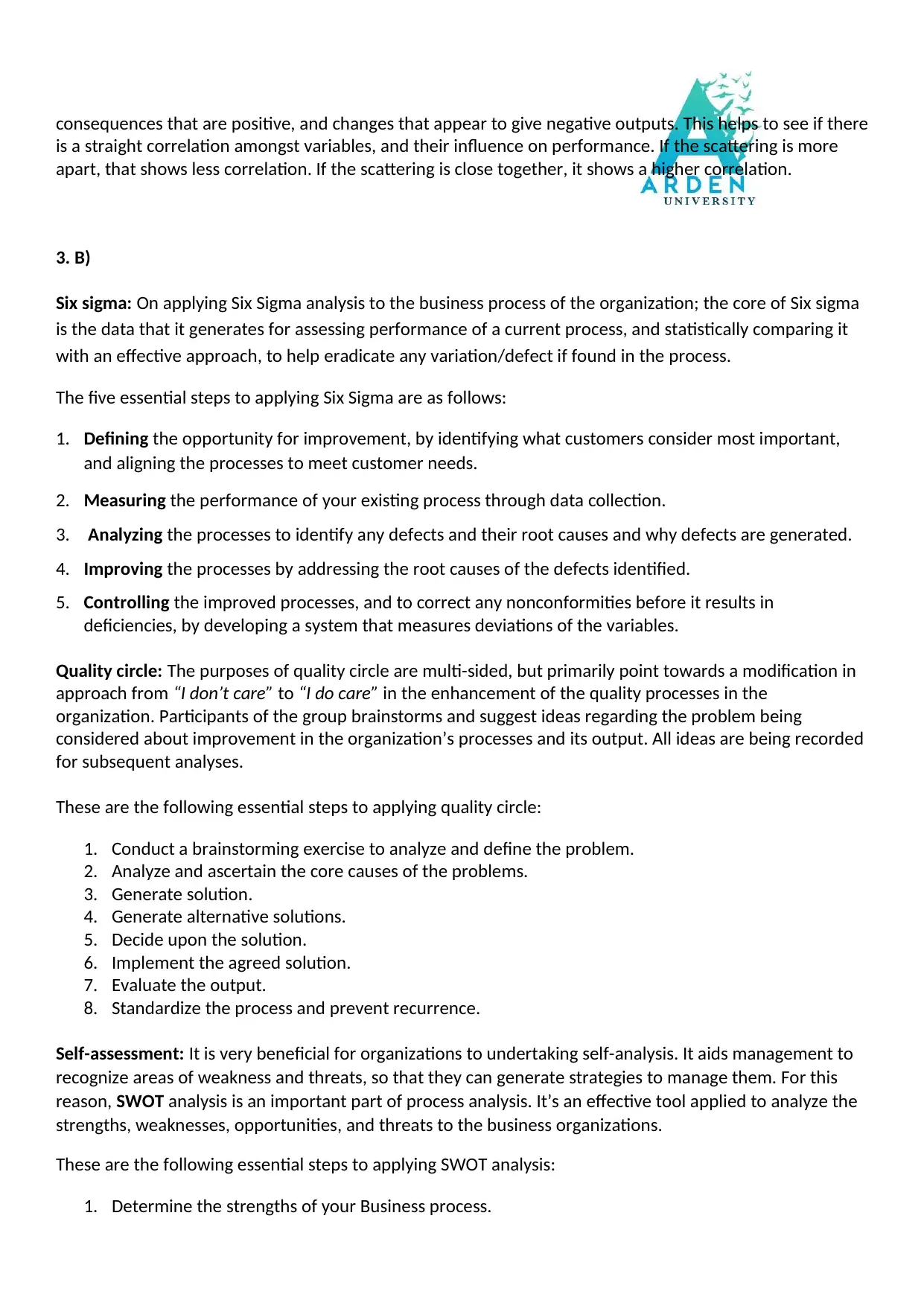
consequences that are positive, and changes that appear to give negative outputs. This helps to see if there
is a straight correlation amongst variables, and their influence on performance. If the scattering is more
apart, that shows less correlation. If the scattering is close together, it shows a higher correlation.
3. B)
Six sigma: On applying Six Sigma analysis to the business process of the organization; the core of Six sigma
is the data that it generates for assessing performance of a current process, and statistically comparing it
with an effective approach, to help eradicate any variation/defect if found in the process.
The five essential steps to applying Six Sigma are as follows:
1. Defining the opportunity for improvement, by identifying what customers consider most important,
and aligning the processes to meet customer needs.
2. Measuring the performance of your existing process through data collection.
3. Analyzing the processes to identify any defects and their root causes and why defects are generated.
4. Improving the processes by addressing the root causes of the defects identified.
5. Controlling the improved processes, and to correct any nonconformities before it results in
deficiencies, by developing a system that measures deviations of the variables.
Quality circle: The purposes of quality circle are multi-sided, but primarily point towards a modification in
approach from “I don’t care” to “I do care” in the enhancement of the quality processes in the
organization. Participants of the group brainstorms and suggest ideas regarding the problem being
considered about improvement in the organization’s processes and its output. All ideas are being recorded
for subsequent analyses.
These are the following essential steps to applying quality circle:
1. Conduct a brainstorming exercise to analyze and define the problem.
2. Analyze and ascertain the core causes of the problems.
3. Generate solution.
4. Generate alternative solutions.
5. Decide upon the solution.
6. Implement the agreed solution.
7. Evaluate the output.
8. Standardize the process and prevent recurrence.
Self-assessment: It is very beneficial for organizations to undertaking self-analysis. It aids management to
recognize areas of weakness and threats, so that they can generate strategies to manage them. For this
reason, SWOT analysis is an important part of process analysis. It’s an effective tool applied to analyze the
strengths, weaknesses, opportunities, and threats to the business organizations.
These are the following essential steps to applying SWOT analysis:
1. Determine the strengths of your Business process.
is a straight correlation amongst variables, and their influence on performance. If the scattering is more
apart, that shows less correlation. If the scattering is close together, it shows a higher correlation.
3. B)
Six sigma: On applying Six Sigma analysis to the business process of the organization; the core of Six sigma
is the data that it generates for assessing performance of a current process, and statistically comparing it
with an effective approach, to help eradicate any variation/defect if found in the process.
The five essential steps to applying Six Sigma are as follows:
1. Defining the opportunity for improvement, by identifying what customers consider most important,
and aligning the processes to meet customer needs.
2. Measuring the performance of your existing process through data collection.
3. Analyzing the processes to identify any defects and their root causes and why defects are generated.
4. Improving the processes by addressing the root causes of the defects identified.
5. Controlling the improved processes, and to correct any nonconformities before it results in
deficiencies, by developing a system that measures deviations of the variables.
Quality circle: The purposes of quality circle are multi-sided, but primarily point towards a modification in
approach from “I don’t care” to “I do care” in the enhancement of the quality processes in the
organization. Participants of the group brainstorms and suggest ideas regarding the problem being
considered about improvement in the organization’s processes and its output. All ideas are being recorded
for subsequent analyses.
These are the following essential steps to applying quality circle:
1. Conduct a brainstorming exercise to analyze and define the problem.
2. Analyze and ascertain the core causes of the problems.
3. Generate solution.
4. Generate alternative solutions.
5. Decide upon the solution.
6. Implement the agreed solution.
7. Evaluate the output.
8. Standardize the process and prevent recurrence.
Self-assessment: It is very beneficial for organizations to undertaking self-analysis. It aids management to
recognize areas of weakness and threats, so that they can generate strategies to manage them. For this
reason, SWOT analysis is an important part of process analysis. It’s an effective tool applied to analyze the
strengths, weaknesses, opportunities, and threats to the business organizations.
These are the following essential steps to applying SWOT analysis:
1. Determine the strengths of your Business process.
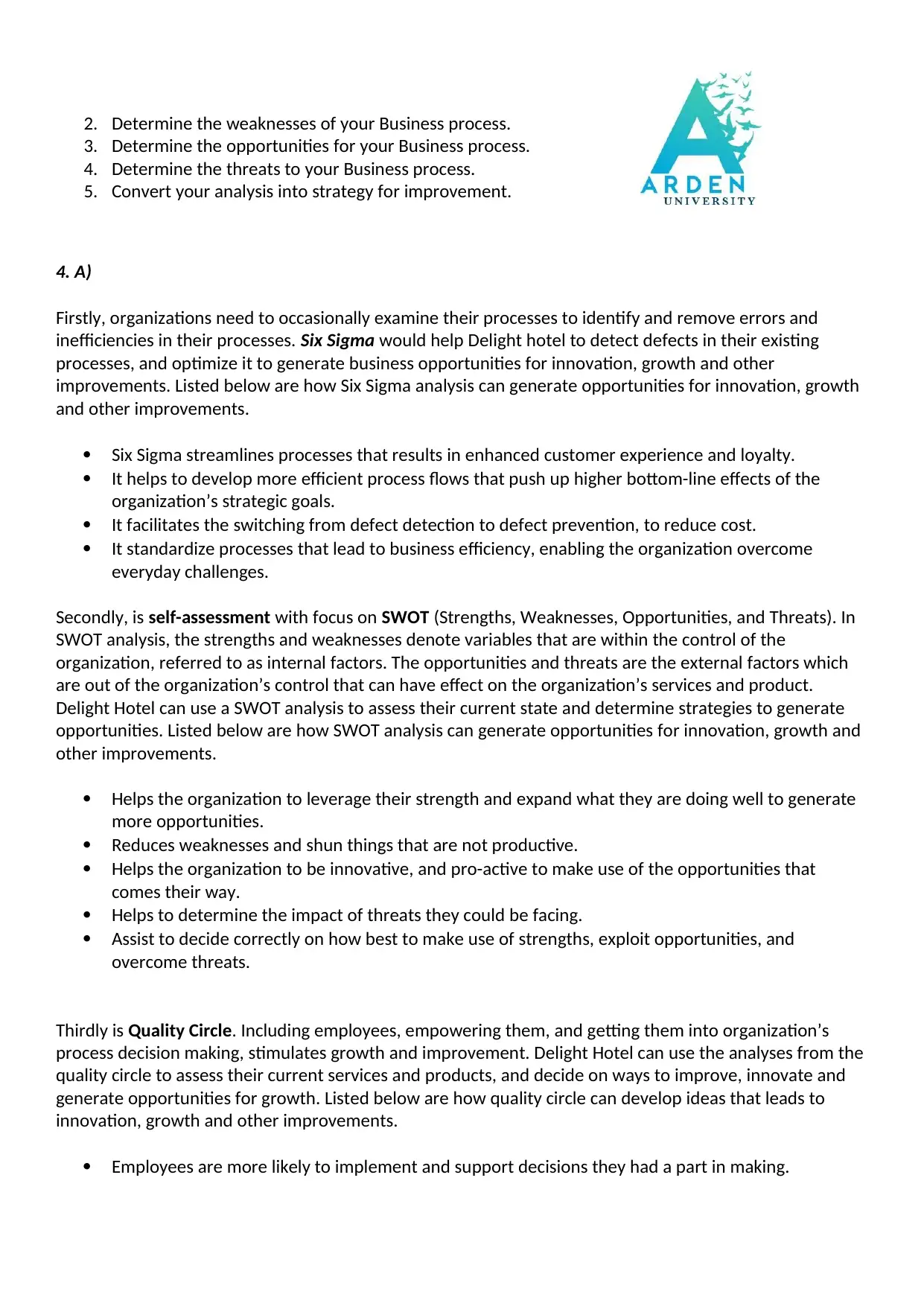
2. Determine the weaknesses of your Business process.
3. Determine the opportunities for your Business process.
4. Determine the threats to your Business process.
5. Convert your analysis into strategy for improvement.
4. A)
Firstly, organizations need to occasionally examine their processes to identify and remove errors and
inefficiencies in their processes. Six Sigma would help Delight hotel to detect defects in their existing
processes, and optimize it to generate business opportunities for innovation, growth and other
improvements. Listed below are how Six Sigma analysis can generate opportunities for innovation, growth
and other improvements.
Six Sigma streamlines processes that results in enhanced customer experience and loyalty.
It helps to develop more efficient process flows that push up higher bottom-line effects of the
organization’s strategic goals.
It facilitates the switching from defect detection to defect prevention, to reduce cost.
It standardize processes that lead to business efficiency, enabling the organization overcome
everyday challenges.
Secondly, is self-assessment with focus on SWOT (Strengths, Weaknesses, Opportunities, and Threats). In
SWOT analysis, the strengths and weaknesses denote variables that are within the control of the
organization, referred to as internal factors. The opportunities and threats are the external factors which
are out of the organization’s control that can have effect on the organization’s services and product.
Delight Hotel can use a SWOT analysis to assess their current state and determine strategies to generate
opportunities. Listed below are how SWOT analysis can generate opportunities for innovation, growth and
other improvements.
Helps the organization to leverage their strength and expand what they are doing well to generate
more opportunities.
Reduces weaknesses and shun things that are not productive.
Helps the organization to be innovative, and pro-active to make use of the opportunities that
comes their way.
Helps to determine the impact of threats they could be facing.
Assist to decide correctly on how best to make use of strengths, exploit opportunities, and
overcome threats.
Thirdly is Quality Circle. Including employees, empowering them, and getting them into organization’s
process decision making, stimulates growth and improvement. Delight Hotel can use the analyses from the
quality circle to assess their current services and products, and decide on ways to improve, innovate and
generate opportunities for growth. Listed below are how quality circle can develop ideas that leads to
innovation, growth and other improvements.
Employees are more likely to implement and support decisions they had a part in making.
3. Determine the opportunities for your Business process.
4. Determine the threats to your Business process.
5. Convert your analysis into strategy for improvement.
4. A)
Firstly, organizations need to occasionally examine their processes to identify and remove errors and
inefficiencies in their processes. Six Sigma would help Delight hotel to detect defects in their existing
processes, and optimize it to generate business opportunities for innovation, growth and other
improvements. Listed below are how Six Sigma analysis can generate opportunities for innovation, growth
and other improvements.
Six Sigma streamlines processes that results in enhanced customer experience and loyalty.
It helps to develop more efficient process flows that push up higher bottom-line effects of the
organization’s strategic goals.
It facilitates the switching from defect detection to defect prevention, to reduce cost.
It standardize processes that lead to business efficiency, enabling the organization overcome
everyday challenges.
Secondly, is self-assessment with focus on SWOT (Strengths, Weaknesses, Opportunities, and Threats). In
SWOT analysis, the strengths and weaknesses denote variables that are within the control of the
organization, referred to as internal factors. The opportunities and threats are the external factors which
are out of the organization’s control that can have effect on the organization’s services and product.
Delight Hotel can use a SWOT analysis to assess their current state and determine strategies to generate
opportunities. Listed below are how SWOT analysis can generate opportunities for innovation, growth and
other improvements.
Helps the organization to leverage their strength and expand what they are doing well to generate
more opportunities.
Reduces weaknesses and shun things that are not productive.
Helps the organization to be innovative, and pro-active to make use of the opportunities that
comes their way.
Helps to determine the impact of threats they could be facing.
Assist to decide correctly on how best to make use of strengths, exploit opportunities, and
overcome threats.
Thirdly is Quality Circle. Including employees, empowering them, and getting them into organization’s
process decision making, stimulates growth and improvement. Delight Hotel can use the analyses from the
quality circle to assess their current services and products, and decide on ways to improve, innovate and
generate opportunities for growth. Listed below are how quality circle can develop ideas that leads to
innovation, growth and other improvements.
Employees are more likely to implement and support decisions they had a part in making.
⊘ This is a preview!⊘
Do you want full access?
Subscribe today to unlock all pages.

Trusted by 1+ million students worldwide
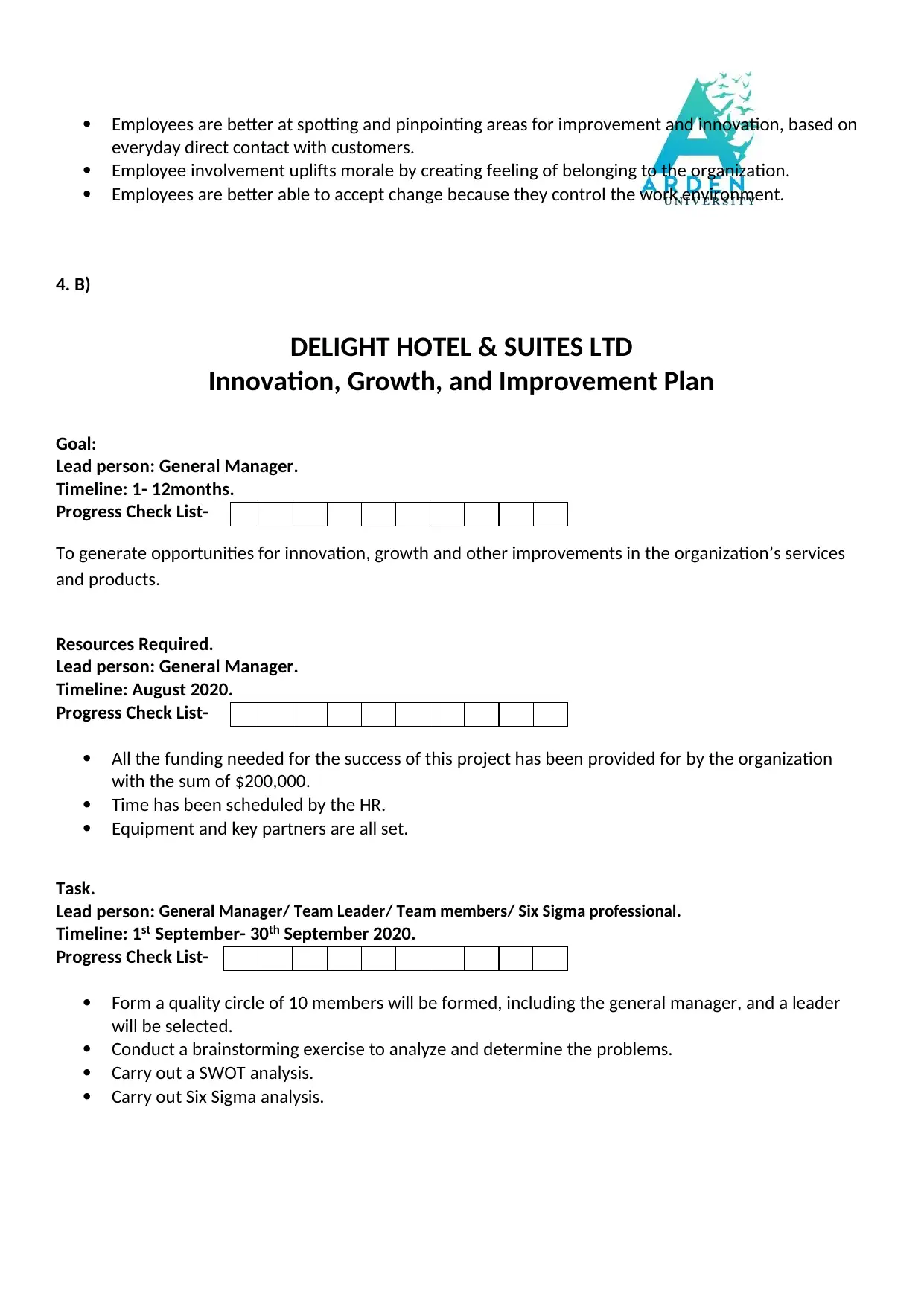
Employees are better at spotting and pinpointing areas for improvement and innovation, based on
everyday direct contact with customers.
Employee involvement uplifts morale by creating feeling of belonging to the organization.
Employees are better able to accept change because they control the work environment.
4. B)
DELIGHT HOTEL & SUITES LTD
Innovation, Growth, and Improvement Plan
Goal:
Lead person: General Manager.
Timeline: 1- 12months.
Progress Check List-
To generate opportunities for innovation, growth and other improvements in the organization’s services
and products.
Resources Required.
Lead person: General Manager.
Timeline: August 2020.
Progress Check List-
All the funding needed for the success of this project has been provided for by the organization
with the sum of $200,000.
Time has been scheduled by the HR.
Equipment and key partners are all set.
Task.
Lead person: General Manager/ Team Leader/ Team members/ Six Sigma professional.
Timeline: 1st September- 30th September 2020.
Progress Check List-
Form a quality circle of 10 members will be formed, including the general manager, and a leader
will be selected.
Conduct a brainstorming exercise to analyze and determine the problems.
Carry out a SWOT analysis.
Carry out Six Sigma analysis.
everyday direct contact with customers.
Employee involvement uplifts morale by creating feeling of belonging to the organization.
Employees are better able to accept change because they control the work environment.
4. B)
DELIGHT HOTEL & SUITES LTD
Innovation, Growth, and Improvement Plan
Goal:
Lead person: General Manager.
Timeline: 1- 12months.
Progress Check List-
To generate opportunities for innovation, growth and other improvements in the organization’s services
and products.
Resources Required.
Lead person: General Manager.
Timeline: August 2020.
Progress Check List-
All the funding needed for the success of this project has been provided for by the organization
with the sum of $200,000.
Time has been scheduled by the HR.
Equipment and key partners are all set.
Task.
Lead person: General Manager/ Team Leader/ Team members/ Six Sigma professional.
Timeline: 1st September- 30th September 2020.
Progress Check List-
Form a quality circle of 10 members will be formed, including the general manager, and a leader
will be selected.
Conduct a brainstorming exercise to analyze and determine the problems.
Carry out a SWOT analysis.
Carry out Six Sigma analysis.
Paraphrase This Document
Need a fresh take? Get an instant paraphrase of this document with our AI Paraphraser
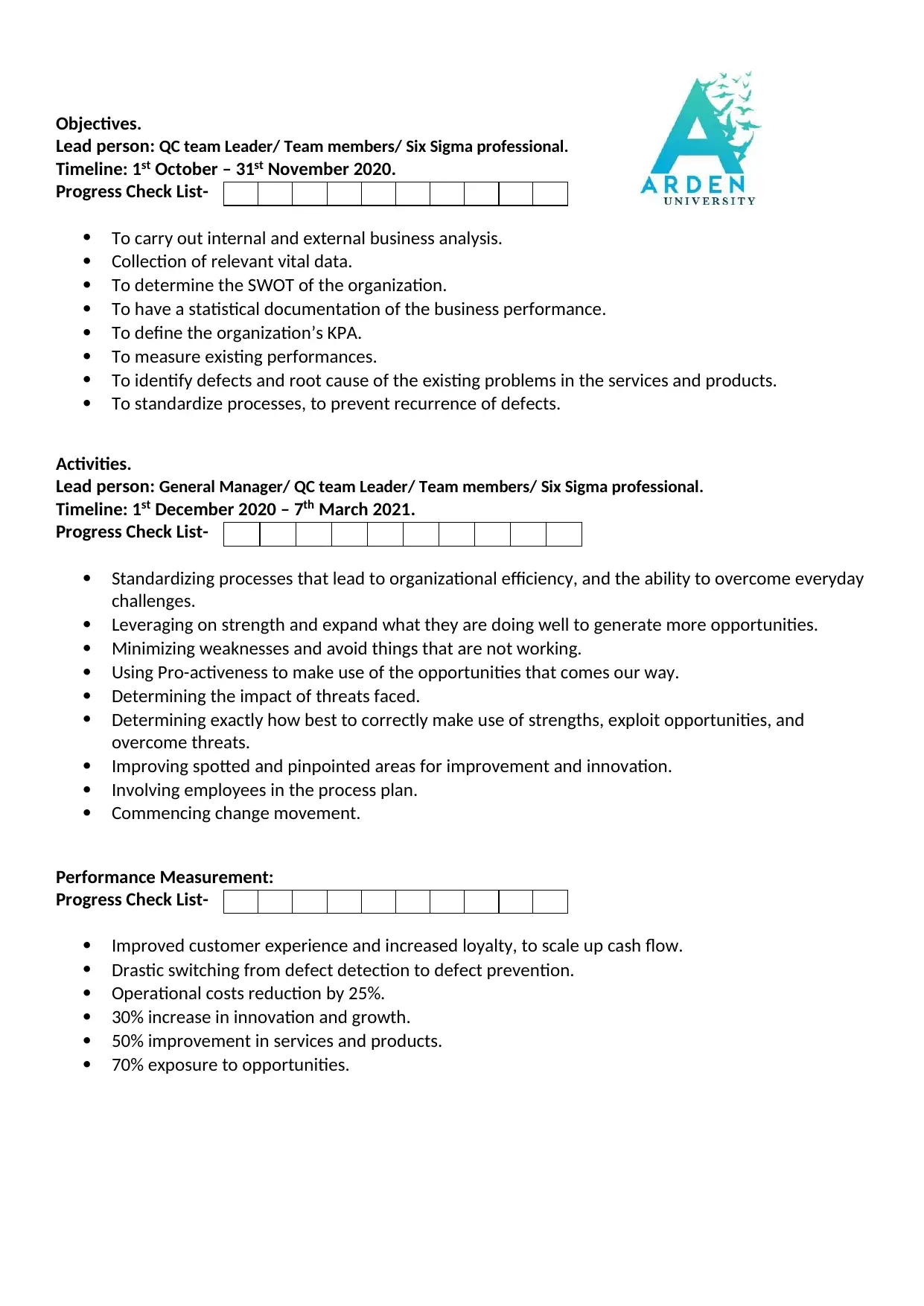
Objectives.
Lead person: QC team Leader/ Team members/ Six Sigma professional.
Timeline: 1st October – 31st November 2020.
Progress Check List-
To carry out internal and external business analysis.
Collection of relevant vital data.
To determine the SWOT of the organization.
To have a statistical documentation of the business performance.
To define the organization’s KPA.
To measure existing performances.
To identify defects and root cause of the existing problems in the services and products.
To standardize processes, to prevent recurrence of defects.
Activities.
Lead person: General Manager/ QC team Leader/ Team members/ Six Sigma professional.
Timeline: 1st December 2020 – 7th March 2021.
Progress Check List-
Standardizing processes that lead to organizational efficiency, and the ability to overcome everyday
challenges.
Leveraging on strength and expand what they are doing well to generate more opportunities.
Minimizing weaknesses and avoid things that are not working.
Using Pro-activeness to make use of the opportunities that comes our way.
Determining the impact of threats faced.
Determining exactly how best to correctly make use of strengths, exploit opportunities, and
overcome threats.
Improving spotted and pinpointed areas for improvement and innovation.
Involving employees in the process plan.
Commencing change movement.
Performance Measurement:
Progress Check List-
Improved customer experience and increased loyalty, to scale up cash flow.
Drastic switching from defect detection to defect prevention.
Operational costs reduction by 25%.
30% increase in innovation and growth.
50% improvement in services and products.
70% exposure to opportunities.
Lead person: QC team Leader/ Team members/ Six Sigma professional.
Timeline: 1st October – 31st November 2020.
Progress Check List-
To carry out internal and external business analysis.
Collection of relevant vital data.
To determine the SWOT of the organization.
To have a statistical documentation of the business performance.
To define the organization’s KPA.
To measure existing performances.
To identify defects and root cause of the existing problems in the services and products.
To standardize processes, to prevent recurrence of defects.
Activities.
Lead person: General Manager/ QC team Leader/ Team members/ Six Sigma professional.
Timeline: 1st December 2020 – 7th March 2021.
Progress Check List-
Standardizing processes that lead to organizational efficiency, and the ability to overcome everyday
challenges.
Leveraging on strength and expand what they are doing well to generate more opportunities.
Minimizing weaknesses and avoid things that are not working.
Using Pro-activeness to make use of the opportunities that comes our way.
Determining the impact of threats faced.
Determining exactly how best to correctly make use of strengths, exploit opportunities, and
overcome threats.
Improving spotted and pinpointed areas for improvement and innovation.
Involving employees in the process plan.
Commencing change movement.
Performance Measurement:
Progress Check List-
Improved customer experience and increased loyalty, to scale up cash flow.
Drastic switching from defect detection to defect prevention.
Operational costs reduction by 25%.
30% increase in innovation and growth.
50% improvement in services and products.
70% exposure to opportunities.
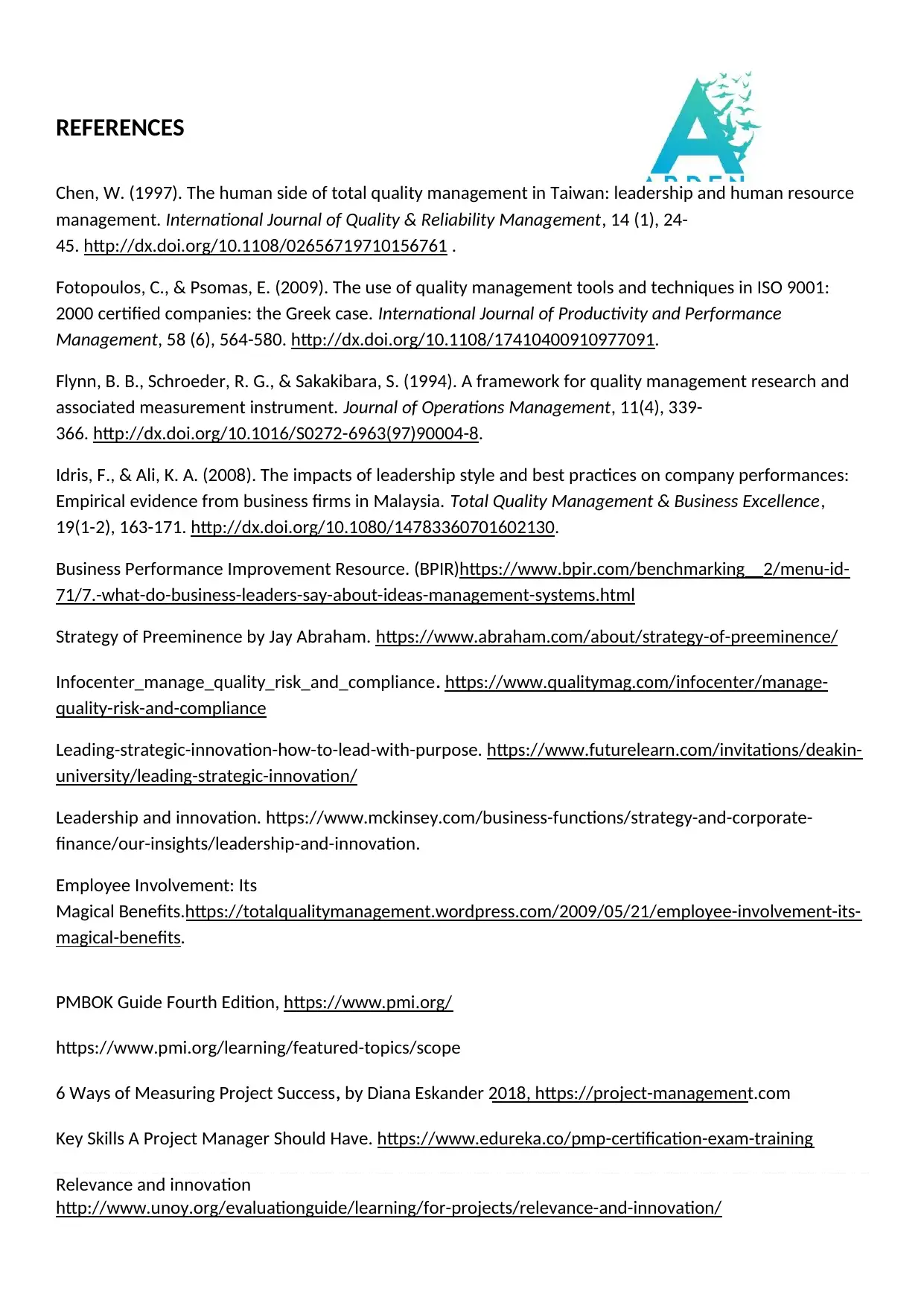
REFERENCES
Chen, W. (1997). The human side of total quality management in Taiwan: leadership and human resource
management. International Journal of Quality & Reliability Management, 14 (1), 24-
45. http://dx.doi.org/10.1108/02656719710156761 .
Fotopoulos, C., & Psomas, E. (2009). The use of quality management tools and techniques in ISO 9001:
2000 certified companies: the Greek case. International Journal of Productivity and Performance
Management, 58 (6), 564-580. http://dx.doi.org/10.1108/17410400910977091.
Flynn, B. B., Schroeder, R. G., & Sakakibara, S. (1994). A framework for quality management research and
associated measurement instrument. Journal of Operations Management, 11(4), 339-
366. http://dx.doi.org/10.1016/S0272-6963(97)90004-8.
Idris, F., & Ali, K. A. (2008). The impacts of leadership style and best practices on company performances:
Empirical evidence from business firms in Malaysia. Total Quality Management & Business Excellence,
19(1-2), 163-171. http://dx.doi.org/10.1080/14783360701602130.
Business Performance Improvement Resource. (BPIR)https://www.bpir.com/benchmarking__2/menu-id-
71/7.-what-do-business-leaders-say-about-ideas-management-systems.html
Strategy of Preeminence by Jay Abraham. https://www.abraham.com/about/strategy-of-preeminence/
Infocenter_manage_quality_risk_and_compliance. https://www.qualitymag.com/infocenter/manage-
quality-risk-and-compliance
Leading-strategic-innovation-how-to-lead-with-purpose. https://www.futurelearn.com/invitations/deakin-
university/leading-strategic-innovation/
Leadership and innovation. https://www.mckinsey.com/business-functions/strategy-and-corporate-
finance/our-insights/leadership-and-innovation.
Employee Involvement: Its
Magical Benefits.https://totalqualitymanagement.wordpress.com/2009/05/21/employee-involvement-its-
magical-benefits.
PMBOK Guide Fourth Edition, https://www.pmi.org/
https://www.pmi.org/learning/featured-topics/scope
6 Ways of Measuring Project Success, by Diana Eskander 2018, https://project-management.com
Key Skills A Project Manager Should Have. https://www.edureka.co/pmp-certification-exam-training
Relevance and innovation
http://www.unoy.org/evaluationguide/learning/for-projects/relevance-and-innovation/
Chen, W. (1997). The human side of total quality management in Taiwan: leadership and human resource
management. International Journal of Quality & Reliability Management, 14 (1), 24-
45. http://dx.doi.org/10.1108/02656719710156761 .
Fotopoulos, C., & Psomas, E. (2009). The use of quality management tools and techniques in ISO 9001:
2000 certified companies: the Greek case. International Journal of Productivity and Performance
Management, 58 (6), 564-580. http://dx.doi.org/10.1108/17410400910977091.
Flynn, B. B., Schroeder, R. G., & Sakakibara, S. (1994). A framework for quality management research and
associated measurement instrument. Journal of Operations Management, 11(4), 339-
366. http://dx.doi.org/10.1016/S0272-6963(97)90004-8.
Idris, F., & Ali, K. A. (2008). The impacts of leadership style and best practices on company performances:
Empirical evidence from business firms in Malaysia. Total Quality Management & Business Excellence,
19(1-2), 163-171. http://dx.doi.org/10.1080/14783360701602130.
Business Performance Improvement Resource. (BPIR)https://www.bpir.com/benchmarking__2/menu-id-
71/7.-what-do-business-leaders-say-about-ideas-management-systems.html
Strategy of Preeminence by Jay Abraham. https://www.abraham.com/about/strategy-of-preeminence/
Infocenter_manage_quality_risk_and_compliance. https://www.qualitymag.com/infocenter/manage-
quality-risk-and-compliance
Leading-strategic-innovation-how-to-lead-with-purpose. https://www.futurelearn.com/invitations/deakin-
university/leading-strategic-innovation/
Leadership and innovation. https://www.mckinsey.com/business-functions/strategy-and-corporate-
finance/our-insights/leadership-and-innovation.
Employee Involvement: Its
Magical Benefits.https://totalqualitymanagement.wordpress.com/2009/05/21/employee-involvement-its-
magical-benefits.
PMBOK Guide Fourth Edition, https://www.pmi.org/
https://www.pmi.org/learning/featured-topics/scope
6 Ways of Measuring Project Success, by Diana Eskander 2018, https://project-management.com
Key Skills A Project Manager Should Have. https://www.edureka.co/pmp-certification-exam-training
Relevance and innovation
http://www.unoy.org/evaluationguide/learning/for-projects/relevance-and-innovation/
⊘ This is a preview!⊘
Do you want full access?
Subscribe today to unlock all pages.

Trusted by 1+ million students worldwide
1 out of 13
Related Documents
Your All-in-One AI-Powered Toolkit for Academic Success.
+13062052269
info@desklib.com
Available 24*7 on WhatsApp / Email
![[object Object]](/_next/static/media/star-bottom.7253800d.svg)
Unlock your academic potential
Copyright © 2020–2025 A2Z Services. All Rights Reserved. Developed and managed by ZUCOL.





